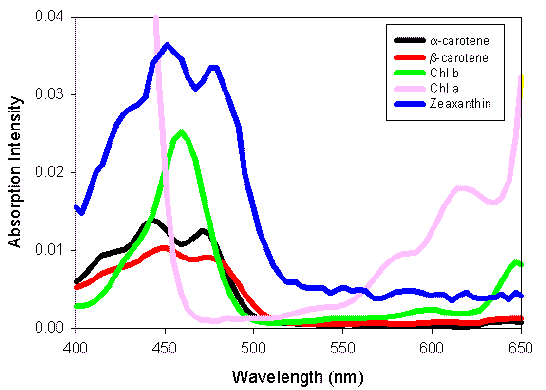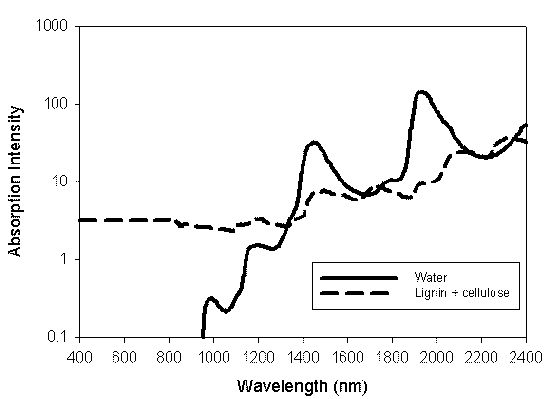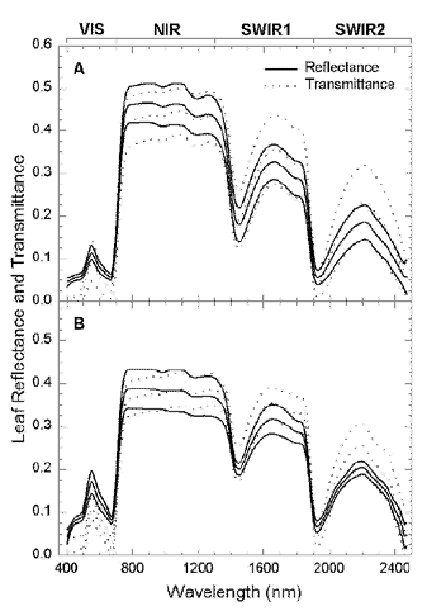Plant foliage, including leaves, needles, and other green materials, often look similar to the casual observer, but they vary widely in both shape and chemical composition. The chemical composition of leaves can often be estimated using VIs, but doing so requires some knowledge of the basic composition of leaves and how they change under different environmental conditions. The most important leaf components that affect their spectral properties are:
- Pigments
- Water
- Carbon
- Nitrogen
These components are described in the sections that follow. Other components (such as phosphorus, calcium, and so forth) are significant to plant function, but they do not directly contribute to the spectral properties of leaves, and therefore cannot be directly measured using remotely sensed data.
Pigments
There are three main categories of leaf pigments in plants: chlorophyll, carotenoids, and anthocyanins. These pigments serve a variety of purposes, and are critical to the function and health of vegetation, though the relative concentrations of these pigments in vegetation can vary significantly. Vegetation with a high concentration of chlorophyll is generally very healthy, as chlorophyll is linked to greater light use efficiency or photosynthetic rates. Conversely, carotenoid and anthocyanin pigments often appear in higher concentrations in vegetation that is less healthy, typically due to stress or the onset of senescence (dormant or dying vegetation that appears red, yellow, or brown).
Chlorophyll, the most well-known and most important pigment, causes the green color of healthy plant leaves. It is primarily responsible for photosynthesis, the process by which plants take up carbon dioxide (CO2) from the atmosphere and convert it into organic forms such as sugar and starch. Chlorophyll concentrations in leaves are broadly correlated with photosynthetic rates. Chlorophyll-a and -b pigments most closely associated with photosynthesis.
Carotenoids are a group of pigments containing alpha-carotene, beta-carotene, and xanthophyll pigments (for example, zeaxanthin). Carotene is the yellow-orange pigment found in tree leaves as they change from green to brown (as seen during autumn). Carotenoid pigments have multiple functions, but they are generally found in higher concentrations in plant leaves that are either stressed (seen in drought or nutrient depletion), senescent, or dead. Carotenoids assist the process of light absorption in plants, and help protect plants from the harmful effects of very high light conditions.
Anthocyanins also have multiple functions, but are typically related to changes in foliage. Anthocyanins are reddish pigments abundant in both newly forming leaves and leaves undergoing senescence. Anthocyanins also serve to protect leaves from damage due to ultraviolet radiation.
As a group, leaf pigments only affect the visible portion of the shortwave spectrum (400 nm to 700 nm), though the affects vary depending upon the type of pigment. The following figure shows the absorption of each pigment type as a function of wavelength throughout the visible range.

Water
Plants of different species inherently contain different amounts of water based on their leaf geometry, canopy architecture, and water requirements. Among plants of one species, there is still significant variation, depending upon leaf thickness, water availability, and plant health. Water is critical for many plant processes, in particular, photosynthesis. Generally, vegetation of the same type with greater water content is more productive and less prone to burn.
Leaf water affects plant reflectance in the near-infrared and shortwave infrared regions of the spectrum (see the following figure). Water has maximum absorptions centered near 1400 and 1900 nm, but these spectral regions usually cannot be observed from airborne or space-based sensors due to atmospheric water absorption, preventing their practical use in the creation of VIs. Water features centered around 970 nm and 1190 nm are pronounced and can be readily measured from hyperspectral sensors. These spectral regions are generally not sampled by multispectral sensors.
Carbon
Plants contain carbon in many forms, including sugars, starch, cellulose, and lignin. Sugars and starch are immediate products of photosynthesis; they are moved to other locations in plants to construct cellulose and lignin. Cellulose is primarily used in the construction of cell walls in plant tissues. Lignin is used for the most structurally robust portions of plants, such as leaf vacuoles, veins, woody tissue, and roots. Cellulose and lignin display spectral features in the shortwave infrared range of the shortwave optical spectrum, as the following figure shows.

Nitrogen
Leaves contain nitrogen bound in the chlorophyll pigment, proteins, and other molecules. Nitrogen concentrations in foliage are linked to maximum photosynthetic rate and net primary production. VIs sensitive to chlorophyll content (which is approximately 6% nitrogen) are often broadly sensitive to nitrogen content as well. Some proteins that contain nitrogen affect the spectral properties of leaves in the 1500 nm to 1720 nm range.
Combined Leaf Level Absorption
The interaction of radiation with foliage is primarily a function of the reflectance properties of leaf components. In the visible range, the main signal comes from the absorption of incident radiation by the leaf pigments chlorophyll, carotenoids, and anthocyanins. In the near-infrared, the primary contribution comes from the absorption of water. The reflectance in the shortwave infrared range is partially determined by water, but the reflectance also receives significant contributions from the reflectance of nitrogen and various forms of carbon.
The following figures show examples of leaf reflectance and transmittance spectra:

See Also
Spectral Indices, Vegetation Indices, Vegetation Analysis Tools, Vegetation and Its Reflectance Properties